F-22 “Raptor” fighter jets late Monday intercepted four Russian warplanes and identified a fifth flying within 30 nautical miles (34 miles) off the Alaskan coast, according to North American Aerospace Defense Command (NORAD).

In a follow-up post, NORAD said it had also positively identified a Russian A-50 airborne early warning and control aircraft, which loitered within the Alaskan Air Defense Identification Zone for approximately an hour-and-a-half and came within 30 nautical miles of Alaskan shores.
All the Russian warplanes remained in international airspace at all times and did not enter U.S. or Canadian airspace, NORAD said.
“NORAD forces remain on alert 24/7/365 to respond to potential threats to Canada and the United States,” NORAD Commander Gen. Glen D. VanHerck said on Twitter. “The agility and readiness of our personnel ensures we are successful in addressing potential aerospace threats with the appropriate response at the right time.”
Russia’s Ministry of Defense on Tuesday also published footage of its bomber formations being intercepted near Alaska.
Intercepts of Russian aircraft in the air defense identification zone established around Alaska have occurred numerous times in recent months. In late August, fighter jets assigned to NORAD intercepted three formations of two Tu-142 Russian maritime patrol aircraft that came within 50 nautical miles (57 miles) of the Alaskan coast.
“This year, we’ve conducted more than a dozen intercepts, the most in recent years,” VanHerck said at the time. “The importance of our continued efforts to project air defense operations in and through the north has never been more apparent.”
“We just want to make it very clear to them... there are no vulnerabilities as a result of COVID-19,” O'Shaughnessy said. “We are postured and maintain that ability to respond at a moment’s notice.”





